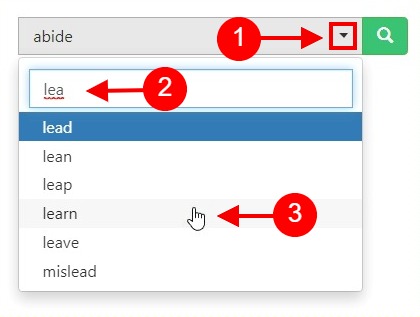Konjugaatio [coerce]
konjugointi on luoda johdettuja muotoja verbin sen pääasiallinen osaa taivutus (muutos muodon mukaan kielioppisääntöjen). Esimerkiksi verbi "tauko" voidaan konjugoida muodostamiseksi sanat murtaa, taukoja, rikki, rikki ja karkaa.
Termi konjugointi käytetään vain taivutus verbien, eikä muiden osien puhe (taivutus substantiiveja ja adjektiiveja tunnetaan deklinaatio). Myös se rajoittuu usein ilmaiseva muodostumista rajallinen muodot verbi - nämä voidaan nimitystä konjugoitu muotoja, toisin kuin ei-äärellinen muodoissa, kuten infinitiivin tai gerundi, joka ei yleensä merkitty useimpien kielioppikategorioihin.
konjugointi on myös perinteinen nimi ryhmälle verbejä, jotka jakavat samanlaisen konjugaatio mallia tietyllä kielellä (verbi luokka). Verbi, joka ei noudata kaikkia standardin konjugoinnin kuviot kielen sanotaan olevan epäsäännöllinen verbi .
Ehdollinen
(Conditional)
[coerce]
Causality (kutsutaan myös syy tai syy ja seuraus) on vaikutus, jolla toinen tapahtuma, prosessi, tila tai esine (a syy) edistää tuotannon toisen tapahtuman, prosessi, tila tai esine (vaikutus), jossa syy on osittain vastuussa vaikutus, ja vaikutus on osittain riippuvainen syy. Yleensä prosessi on monia syitä, jotka ovat myös sanottu olevan syy tekijöitä, ja kaikki ovat sen ohi. Vaikutus voidaan puolestaan olla syynä tai syynä, monet muut vaikutukset, jotka kaikki ovat sen tulevaisuudessa.
konditionaalia (lyhennetty joht) on Tapaluokka käytetään ehdollisen ilmaista ehdotus, jonka voimassaoloaika on riippuvainen ehdosta, mahdollisesti vaihtoehtoiseen.
Englanti ei ole inflective (morfologisia) konditionaalia, paitsi siltä osin kuin modaaliverbejä voisi saattaa, pitäisi ja voisi saattaa joissakin yhteyksissä katsottava ehdollinen muotoja voi, voi, on ja tulee vastaavasti. Mitä kutsutaan Englanti konditionaalia (tai vain ehdollista) muodostetaan periphrastically käyttämällä modaalinen verbi olisi yhdessä paljain infinitiivi seuraavien verbi. (Joskus tulee käytetään sijasta olisivat mitä ensimmäisen persoonan aihe - katso on ja tulee. Myös edellä mainittu modaaliverbejä voitaisiin saattaa ja pitäisi saattaa korvata olisi osoitukseksi asianmukaista liikennemuotojen lisäksi ehdollisena.)
Ehdollinen esillä
(Conditional present)
Ehdollinen kestopreesens
(Conditional present progressive)
Ehdollinen täydellinen
(Conditional perfect)
Subjunktiv
(Subjunktiv)
[coerce]
konjunktiivi on Tapaluokka, ominaisuus ilmaisun, joka ilmaisee puhujan asenne sitä. Konjunktiivi muodot verbejä käytetään tyypillisesti ilmaisemaan erilaisia tiloja epätodellisuuden kuten toive, tunne, mahdollisuus, tuomion mielestä velvollisuus tai toiminta, joka ei ole vielä tapahtunut; tarkka tilanteita, joissa niitä käytetään vaihtelevat kielikohtaisesti. Konjunktiivi on yksi irrealis tunnelmia, jotka viittaavat siihen, mitä ei välttämättä todellinen. Se on usein vastakkain ohjeelliset, eli Indikatiivi jota käytetään pääasiallisesti osoittamaan, että jotain on tosiasia.
Subjunctives esiintyy useimmiten, vaikkakaan ei yksinomaan, sivulauseet, erityisesti-lausekkeita. Esimerkkejä konjunktiivi in Englanti löytyvät lauseet "Ehdotan, että varo" ja "On tärkeää, että hän pysyä vierelläsi."
konjunktiivi tunnelma Englanti on lauseke käytetään tavallisesti joissakin yhteyksissä jotka kuvaavat ei- todellisista mahdollisuuksista, esim "On tärkeää, että te täällä" ja "On tärkeää, että hän saapua ajoissa." Englanti, konjunktiivi on syntaktinen pikemmin kuin taivutusmuotoja, koska ei ole nimenomaisesti subjunktiivin verbimuoto. Pikemminkin, konjunktiivi lausekkeet rekrytoida paljas verbin jota käytetään myös erilaisia muita rakenteita.
Present konjunktiivi
(Present subjunctive)
Ohi konjunktiivi
(Past subjunctive)
Imperativ
(Imperativ)
[coerce]
imperatiivi on Tapaluokka joka muodostaa komentoa tai pyyntöä.
Esimerkki verbi käytetty imperatiivi on Englanti lause "Go". Tällainen tarpeita, tarkoita toisen henkilön aihe (te), mutta joillakin muilla kielillä on myös ensimmäisen ja kolmannen persoonan vaatimuksina kanssa merkityksessä "nyt (jotain)" tai "anna heidän (jotain)" (Ne voidaan vaihtoehtoisesti kutsutaan cohortative ja jussive).
Partisiippi
(Participle)
[coerce]
Kielitieteessä, partisiippi (ptcp) on muoto nonfinite verbi, joka käsittää perfektiivinen tai continuative aspekti lukuisia aikamuotoja. Partisiippi voi myös toimia adjektiivi tai adverbi. Esimerkiksi "keitetty peruna", keitettyä on partisiipin verbin kiehuvaksi, adjectivally muokkaamalla substantiivi peruna; in "juoksi meitä repaleinen," repaleinen on partisiipin verbin rätti, adverbially täyttäviä verbi juoksi.
Näppäimellä "Satunnaisessa"
| Aloita tutkimus epäsäännöllisiä verbejä: |
| Satunnaisessa = >> |
Englanti epäsäännöllisiä verbejä helppoa ja nopeaa!
